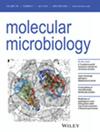FlhG Cooperates With the Cell Cycle Regulator GpsB to Confine Peritrichous Flagella in B. subtilis.
IF 2.6
2区 生物学
Q3 BIOCHEMISTRY & MOLECULAR BIOLOGY
引用次数: 0
Abstract
Number and arrangement of flagella, the bacterial locomotion organelles, are species-specific and serve as key taxonomic markers. The FlhG ATPase (also: YlxH, FleN), along with FlhF, plays pivotal roles in determining flagellation patterns. In Bacillus subtilis, FlhG and FlhF govern the spatial arrangement of peritrichous flagella. FlhG aids in flagellar assembly by interacting with the flagellar C-ring protein FliY, yet the molecular implications of this interaction have been unclear. Our study reveals that the ATP-dependent FlhG homodimer interacts with the C-terminal domain of GpsB, a cell cycle regulator, which recruits the peptidoglycan synthase PBP1 (also: ponA) to sites of cell wall elongation. A deletion of gpsB leads to dysregulation of the flagellation pattern mimicking the effects of a flhG deletion strain. The finding that GpsB can interact simultaneously with FlhG and PBP1, combined with the observation that GpsB and FliY can simultaneously interact with FlhG, strongly argues for a model in which FlhG confines flagella biosynthesis to regions of active cell wall biosynthesis. Thus, the FlhG-GpsB interaction appears to enable the locally restrained stimulation of the GTPase FlhF, known for its role to localize flagella in various bacterial species.FlhG与细胞周期调节因子GpsB协同抑制枯草芽孢杆菌中有营养的鞭毛。
鞭毛是细菌的运动细胞器,其数量和排列具有物种特异性,是细菌分类的关键标志。FlhG atp酶(也称为YlxH, FleN)与FlhF一起在决定鞭毛模式中起关键作用。在枯草芽孢杆菌中,FlhG和FlhF控制着周围鞭毛的空间排列。FlhG通过与鞭毛c环蛋白FliY相互作用来促进鞭毛组装,但这种相互作用的分子意义尚不清楚。我们的研究表明,atp依赖性FlhG同二聚体与细胞周期调节剂GpsB的c端结构域相互作用,将肽聚糖合成酶PBP1(也称为ponA)募集到细胞壁延伸位点。gpsB的缺失导致鞭毛模式的失调,模仿flhG缺失菌株的影响。GpsB可以同时与FlhG和PBP1相互作用的发现,以及GpsB和fly可以同时与FlhG相互作用的观察结果,有力地证明了FlhG将鞭毛生物合成限制在活性细胞壁生物合成区域的模型。因此,FlhG-GpsB相互作用似乎能够局部抑制GTPase FlhF的刺激,而GTPase FlhF以其在各种细菌中定位鞭毛的作用而闻名。
本文章由计算机程序翻译,如有差异,请以英文原文为准。
求助全文
约1分钟内获得全文
求助全文
来源期刊

Molecular Microbiology
生物-生化与分子生物学
CiteScore
7.20
自引率
5.60%
发文量
132
审稿时长
1.7 months
期刊介绍:
Molecular Microbiology, the leading primary journal in the microbial sciences, publishes molecular studies of Bacteria, Archaea, eukaryotic microorganisms, and their viruses.
Research papers should lead to a deeper understanding of the molecular principles underlying basic physiological processes or mechanisms. Appropriate topics include gene expression and regulation, pathogenicity and virulence, physiology and metabolism, synthesis of macromolecules (proteins, nucleic acids, lipids, polysaccharides, etc), cell biology and subcellular organization, membrane biogenesis and function, traffic and transport, cell-cell communication and signalling pathways, evolution and gene transfer. Articles focused on host responses (cellular or immunological) to pathogens or on microbial ecology should be directed to our sister journals Cellular Microbiology and Environmental Microbiology, respectively.
 求助内容:
求助内容: 应助结果提醒方式:
应助结果提醒方式:


